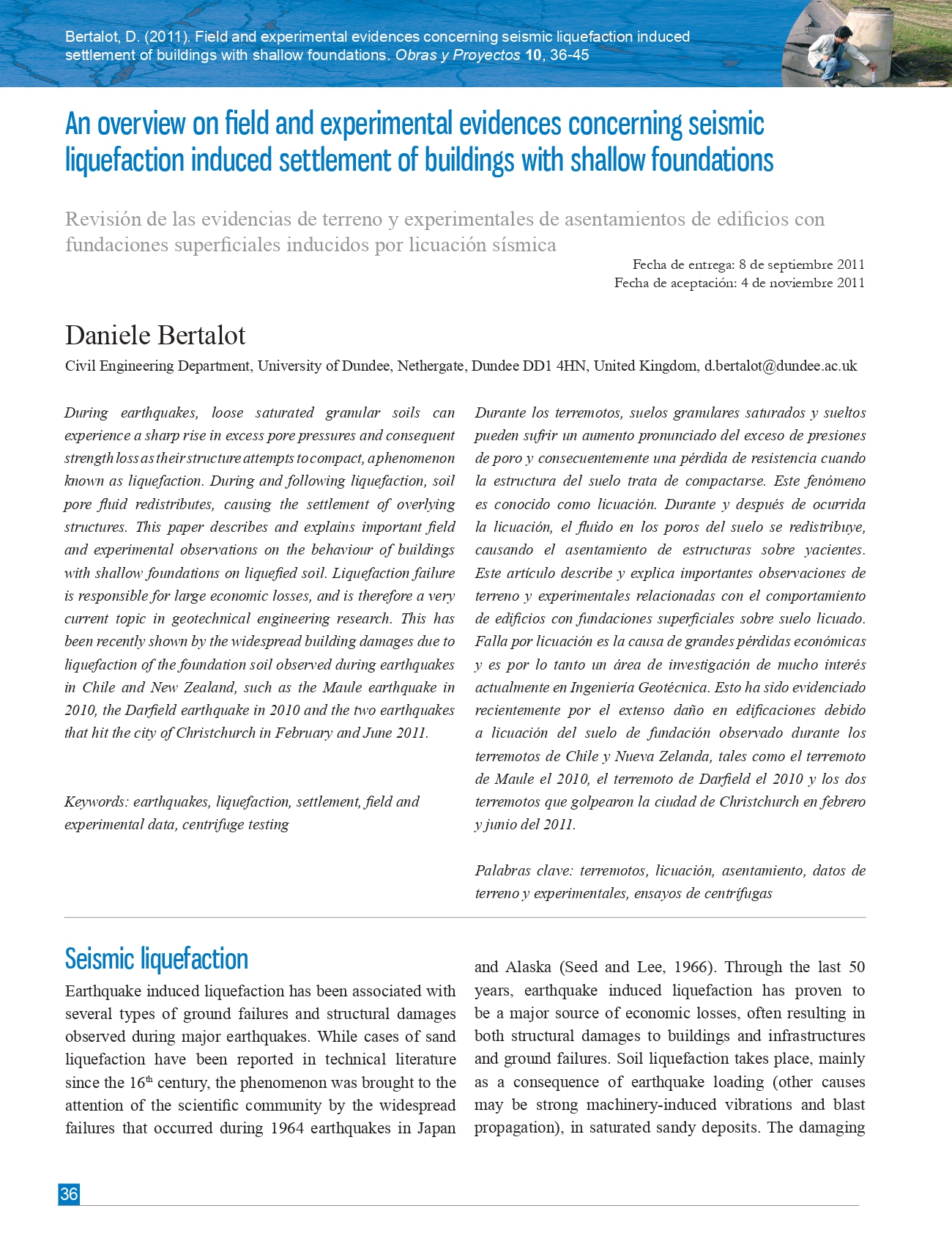Revisión de las evidencias de terreno y experimentales de asentamientos de edificios con fundaciones superficiales inducidos por licuación sísmica
DOI:
https://doi.org/10.4067/S0718-28132011000200004Palabras clave:
terremotos, licuación, asentamiento, datos de terreno y experimentales, ensayos de centrífugasResumen
Durante los terremotos, suelos granulares saturados y sueltos pueden sufrir un aumento pronunciado del exceso de presiones de poro y consecuentemente una pérdida de resistencia cuando la estructura del suelo trata de compactarse. Este fenómeno es conocido como licuación. Durante y después de ocurrida la licuación, el fluido en los poros del suelo se redistribuye, causando el asentamiento de estructuras sobre yacientes. Este artículo describe y explica importantes observaciones de terreno y experimentales relacionadas con el comportamiento de edificios con fundaciones superficiales sobre suelo licuado. Falla por licuación es la causa de grandes pérdidas económicas y es por lo tanto un área de investigación de mucho interés actualmente en Ingeniería Geotécnica. Esto ha sido evidenciado recientemente por el extenso daño en edificaciones debido a licuación del suelo de fundación observado durante los terremotos de Chile y Nueva Zelanda, tales como el terremoto de Maule el 2010, el terremoto de Darfield el 2010 y los dos terremotos que golpearon la ciudad de Christchurch en febrero y junio del 2011.
Referencias
Acacio, A., Kobayashi, Y., Towhata, I., Bautista, R. T. and Ishihara, K. (2001). Subsidence of building foundation resting upon liquefied subsoil: case studies and assessment. Soils and Foundation 41(6), 111-128. https://doi.org/10.3208/sandf.41.6_111
Adachi, T., Iwai, S., Yasui, M. and Sato, Y. (1992). Settlement and inclination of reinforced-concrete buildings in Dagupan-City due to liquefaction during the 1990 Philippine Earthquake. Proceedings of the 10th World Conference on Earthquake Engineering, Vol. 1, 147-152.
Dashti, S., Bray J. D., Pestana, J. M., Riemer, M. and Wilson, D. (2010). Mechanism of seismically induced settlement of buildings with shallow foundation on liquefiable soil. Journal of Geotechnical and Geoenvironmental Engineering ASCE 136(1), 151-164. https://doi.org/10.1061/(ASCE)GT.1943-5606.0000179
EERI (1995). The Hyogo-ken Nanbu (Kobe) earthquake, January 17, 1995: Preliminary Reconnaissance Report, 116p
Fiegel, G.L. and Kutter, B.L. (1994). Mechanism of liquefaction for layered soils. Journal of Geotechnical and Geoenvironmental Engineering ASCE 120(4), 737-755. https://doi.org/10.1061/(ASCE)0733-9410(1994)120:4(737)
Ghalandarzadeh, A. and Khaki Khatibi, A.R. (2003). Study on the behaviour of shallow foundations during liquefaction and mitigation methods by means of 1g shaking table tests. Proceedings BGA International Conference on Foundations, Dundee, 331-340.
Hausler, E. A., (2002). Influence of ground improvement on settlement and liquefaction: a study based on field case history evidence and dynamic geotechnical centrifuge tests. Ph.D. thesis, University of California Berkeley.
Ishihara, K. and Yoshimine, M. (1992). Evaluation of settlements in sand deposits following liquefaction during earthquakes. Soils and Foundations 32(1), 173-188. https://doi.org/10.3208/sandf1972.32.173
Liu, L. and Dobry, R. (1992). Centrifuge study of shallow foundation on saturated sand during earthquakes. Proceedings of the 4th U.S.A. -Japan Workshop on Earthquake Resistant Design of Lifeline Facilities and Countermeasures for Soil Liquefaction, Honolulu, 493-508.
Liu, L. and Dobry, R. (1997). Seismic response of shallow foundation on liquefiable sand. Journal of Geotechnical and Geoenvironmental Engineering ASCE 123(6), 557-567. https://doi.org/10.1061/(ASCE)1090-0241(1997)123:6(557)
Seed, B. and Lee, K.L. (1966). Liquefaction of saturated sands during cyclic loading. Journal of Soil Mechanics and Foundation Division 92, SM6, 105-134. https://doi.org/10.1061/JSFEAQ.0000913
Seed, H.B. and Idriss, I.M. (1971). Simplified procedures for evaluating soil liquefaction potencial. Journal of Soil Mechanics and Foundation Division 97, SM9, 1249-1273. https://doi.org/10.1061/JSFEAQ.0001662
Tokimatsu, K. and Seed, B. (1987). Evaluation of settlements in sand due to earthquake shaking. Journal of Geotechnical Engineering Division ASCE 113, No.8, 861-878.
Tokimatsu, K., Kuwayama, S., Abe, A., and Midorikawa, S. (1994). Liquefaction-induced damage to buildings in 1990 Luzon earthquake. Journal of Geotechnical and Geoenvironmental Engineering ASCE 120(2), 290-303. https://doi.org/10.1061/(ASCE)0733-9410(1994)120:2(290)
USGS (2006). Photographic library. http://libraryphoto.cr.usgs.gov/
Whitman, R.V. and Lambe, P.C. (1982). Liquefaction: consequences for a structure. Proceedings of the Conference on Soil Dynamics and Earthquake Engineering. Rotterdam, 941-949
Yoshimi, Y. and Tokimatsu, K. (1977). Settlement of buildings on saturated sands during earthquakes. Soils and Foundations 17(1), 23-28. https://doi.org/10.3208/sandf1972.17.23

Descargas
Publicado
Número
Sección
Licencia
Derechos de autor 2011 Universidad Católica de la Santísima Concepción

Esta obra está bajo una licencia internacional Creative Commons Atribución-NoComercial 4.0.







